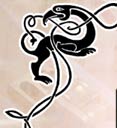Click on any
photo for a
larger version.






|
The cross strung chromatic harp is different from other harps in
that it involves two rows of crossing strings. One row features
diatonic notes only, usually attached to the left side of the
soundboard; the other one features sharp notes only. The
arrangement looks like that of a piano or harpsichord keyboard
with white and black keys. Black strings on the cross strung chromatic
harp are just as easy to sound as white strings. Since the two
string plans are crossing, both hands can play the white strings
or the black strings. Since no special effort, nor apparatus are
involved in the production of accidentals, the cross strung
chromatic harp is a fully chromatic instrument, permanently tune in
the key of "C" (like a piano). From the construction point of view it is also a well balanced design,
because strings are pinned to the neck on either side (except in
the case of some Spanish Arpa de dos ordenes), the instrument has
a better string tension distribution than single rank harps. From a
musical stand point, compared to other harps, this instrument is
suitable to play a wider and more diversified repertoire, that is
virtually all string music, except when glissandi in keys other
than "C" and "C#" are required.
The playing technique for the cross strung chromatic harp
involves a distinct approach and attitude. According to Ben
Brown, a teacher and performer of this instrument (see:
"Introduction to multicourse harps" a video by Ben Brown and
Laurie Riley, available at Laurie Riley, Box 249, Vashon WA
98070) this technique involves
alternative fingering techniques (independence of
the hand, non-consecutive fingering and anticipation. Such
techniques have been described in various available methods (See Ben Brown (in English), or Odile Tackoen (in French)).
Sharp strings (which are easy to see
because they are set in groups of two (c#,d#) and three
(F#,g#,a#) and can be colour coded accordingly, are plucked with the left hand above the crossing line
and with the right hand below the crossing line.
Players of this instrument do not think that playing the cross strung chromatic harp is
more difficult than other harps. This is, I believe the opinion of professional teachers. This
view is not shared by every one, however. The cross strung
chromatic harp is based on a twelve tone octave as opposed to a
seven tone octave. In that sense the fingering may be more
complex. Comparing the cross strung harp to the ordinary diatonic harp is
a bit like saying that a piano with white keys only would be
easier to play... The object of the comparison itself is absurd.
The bottom line is that most Western music is based on the 12 tone
chromatic scale, not on the 7 tone scale, therefore, diatonic instruments
are a bit of a musical paradox, in the "big picture".
What you will need to learn in order to play the cross strung
chromatic harp is indeed a new fingering. Your fingers are used to
"pluck" seven strings per octave, they will have to get used to
plucking twelve strings. According to teachers, with a little
practice, this will become natural pretty quickly!
The main difference in cross strung harp fingering is that
fingers often depart from consecutive sequences:
1,2,3,4...4,3,2,1. In order to be able to reach strings above or
below the crossing line, fingers are called to pluck the strings
in a non-sequential fashion...
Whereas a "C major scale" (no sharps- would be played: 4,3,2,1,
4,3,2,1 on a cross strung harp, just as you would on an ordinary harp... a
"G major scale" (because of the situation of F#) would be played:
3,2,1, 3,2,1, 4,3 from the right hand and... 3,2,1, 4,3,2, 1,3
from the left hand. A "D major scale" would be played: 2,1,4,
3,2,1, 3,2 (RH); 3,2,1, 4,3,2, 1,3 (LH), etc.
Remember that when playing with the right hand, sharps have to be
plucked in the row below the crossing line, this is why here the
4th finger is the most appropriate to pluck F# in a G major scale! When you play with the left
hand this is the opposite, sharps are above the crossing line
and... dictate a different strategy. Again, with a little
practice this becomes natural quickly. The cross strung chromatic
harp has been played for a long time and sophisticated playing
methods are available.

|






